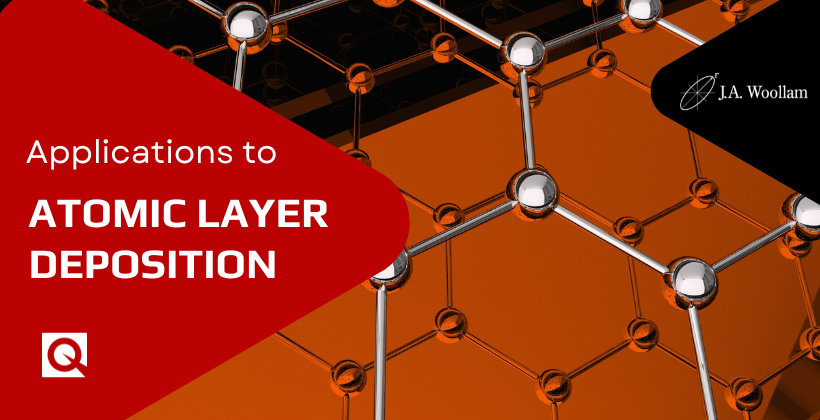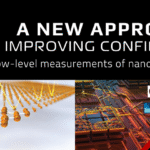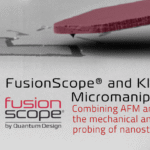
By Jeremy Van Derslice, James Hilfiker, Joshua W. Pinder, and Matthew R. Linford, J. A Woollam Co., Inc, Lincoln, NE USA; Department of Chemistry and Biochemistry, Brigham Young University, Provo UT USA (article originally published in VT&V Magazine, Part 2, November 2022)
Introduction
In situ spectroscopic ellipsometry has become a vital tool for monitoring and studying ALD film growth (and even etch) in real time. The combination of ALD and spectroscopic ellipsometry (SE) is particularly popular because in situ SE measurements are both direct and non-destructive. By ‘direct’ we mean that the measurement probes the sample of interest and not some other surface. (An example of an indirect film thickness measurement is deposition on the quartz surface in a quartz crystal monitor within a deposition chamber. These measurements are generally quite good, but they may not always represent what is happening on the surface in question.) SE is ‘nondestructive’ because the light it uses to probe the surface rarely influences or modifies the surface. Furthermore, SE does not require a thin film to be scratched or cut as for atomic force microscopy, profilometry, or scanning electron microscopy step height or profile measurements.
SE is particularly well suited for determining the thickness of very thin films because it measures the change in the polarisation of the light that reflects from a surface, which includes the phase shift caused by a thin film. This phase information provides sensitivity to very thing films, i.e., those less than 10 nm thick. Thus, SE is ideally suited to ALD because ALD is commonly used to deposit ultra-thin films. This sensitivity is not available from reflection or transmission intensity-based measurements. A final advantage of in situ SE in ALD is the excellent match between the measurement times (data acquisition rates) of modern SE systems and the deposition rates of ALD processes. A full SE spectrum with a thousand wavelengths can be collected in a fraction of a second, giving insight into the chemistry at the surface of an ALD process. These advantages of in situ SE also apply to most other thin film deposition methods.
This article covers various aspects of in situ SE as applied to ALD. We first provide a brief history and overview of ALD. We then discuss the incorporation of SE instruments onto ALD chambers. We end with an overview of in situ SE data analysis, including a brief discussion of modeling concepts for substrates, oxides, and metal films.
A Brief History and Introduction to ALD
These brief comments on the history of ALD comes from Kääriäinen’s excellent book on the subject [6]. The first ALD experiments were performed in the 1960s by Aleskovski in Russia [ref 6 – p.10]. Suntola and coworkers from Finland then worked in this area in the 1970s. [ref 6 – p.11]. Suntola called his method ‘atomic layer epitaxy (ALE).’ However, as ALD evolved, it became clear that many of the films it produces are amorphous, so ‘atomic layer deposition (ALD)’ appeared to be a better name for it. Since the 1970s, there has been increasing interest in ALD. However, when ALD first appeared, it was arguable a niche technique. Nevertheless, ALD has become extremely important in modern technology, and especially for semiconductor manufacturing, because (i) semiconductor device features have decreased to match the thicknesses of the films that are easily produced by ALD, (ii) semiconductor manufacturing relies on the deposition of the top of ultrathin, conformal films that can be produced by ALD (to coat three-dimensional features), and used to deposit many different types of materials, often under conditions that are not extreme – at moderate temperatures and low vacuums, but not extremely low vacuums.

Figure 1. (A) A hydroxyl-terminated surface. (B) The surface in A or C after reaction with TMA. (C) The surface in B after reaction with water. After the introduction of each reagent (TMA or water), there is a purge step in which the unreacted reagent is removed.
In its classical embodiment, ALD is performed in two half cycles/reactions wtih two different gas phase reagents/precursors. In the first half cycle, one of the gas phase reagents is introduced and allowed to react with the surface. Any unreacted reagent is then removed/purged from the system. The second gas phase reagent is then introduced and allowed to react with the surface. Any unreacted second reagent is then removed, and the process is repeated to build up a thing film in a layer-by-layer fashion. This process is illustrated in Figure 1 for the ALD deposition of aluminia from trimethylaluminium (TMA) and water. This deposition often starts with a hydroxyl-terminated surface (see Figure 1A). This surface is then exposed to TMA, which reacts with the surface hydroxyl groups (see Figure 1B). The surface is then exposed to water (see Figure 1C). In each step, aluminium (from TMA) or oxygen (from water) is deposited on the surface. If this process is continued, aluminia films of varying thicknesses can be grown.
In general, ALD reactions are quick – the half reactants used in ALD are often reactive (at least with each other). In addition, ALD half-reactions are designed to be self-limiting. Accordingly, each half-reaction produces up to a monolayer of material on a surface. Accordingly, ALD is not usually the best method for producing very thick films – films that are microns thick, with is the perfect range for modern semiconductor manufacturing. Obviously, ALD relies on the fact that the functional groups created in each half-reaction react with the reagent introduced in the next step. Also, more complex ALD approaches have been developed than that shown in Figure 1, e.g., with plasma activation, with more than two reagents, etc., and the reader is directed to an excellent blog from Eindhoven University of Technology, which provides a thorough database for both ALD and ALE processes [7].
Temperature is a critical parameter in ALD [6]. If the temperature is too low, the reactions will be too slow or a reagent may condense on the surface. However, if it is too high, the reagents may not spend enough times on the surface to react, of they may decompose. Between these extremes is the ‘growth window’. In situ SE has been used for recipe development, including rapidly determining the growth window for a given set of precursors [8]. In addition, ellipsometry has been used for process optimisation where the cycle and purge times are monitored and minimised to improve the deposition rate and save time. Indeed, SE can map out an ALD process, providing important details [9, 10]. For example, Figure 2 shows layer-by-layer growth during a plasma-enhanced ALD (PE-ALD) on Al₂O₃ film. The film thicknesses were determined from SE data collected every 50 ms to easily resolve the deposition process. In Figure 2, the abrupt increases in film thickness and subsequent slanted plateau correspond to the introduction and surface reaction of the aluminium precursor, and the drop to the next slanted plateau, including these plateaus, corresponds to the introduction and reaction of the oxygen plasma.

Figure 2. Plasma enhanced (PE)-ALD of Al₂O₃ measured with 50 ms time resolution. [Data courtesy of V. Vandalon & H. Knoops (Eindhoven University of Technology)]
Incorporation of in situ SE Into ALD Systems
Ellipsometry requires a precise angle of incidence for accurate measurements. For ex situ SE, this angle is easily controlled by precision goniometers that adjust the source and received positions of the instrument with respect to the sample normal. Ex situ measurements often allow complete control over sample alignment (tip-tilt-z), which ensures consistent sample positioning. Unfortunately, this level of precise control is rare for in situ SE. First, the sample resides within a vacuum chamber, while the SE instrument is mounted outside of the chamber. Second, the SE measurement beam reaches the sample after traveling through optical viewports (see Figure 3). These viewports are transparent windows mounted on the chamber, typically with a 2 3⁄4 inch conflat flange, at an angle of incidence of 60 – 75 degrees from the sample normal. The SE receiver is mounted to a port to collect the reflected light at an equal but opposite angle of incidence and limits independent sample alignment. Thus, in situ SE measurements are often acquired at a single angle of incidence with a modified sample alignment procedure. Here, the SE is aligned to the sample rather than the simple being aligned to the SE. That is, the SE source and receiver are each mounted to viewports via adapter plates. The plates allow tip-tilt adjustment to control the measurement beam direction (source) or the internal alignment (receiver/detector). Because the sample is often fixed within the chamber, alignment starts by adjusting the source.

Figure 3. ALD chamber with an in situ ellipsometer (source and receiver) attached to it.
The source is tilted to position the measurement beam on the sample at a position that reflects the light to the receiver window. The receiver unit is then aligned to ensure the measurement beam is inline with the receiver optics. Additionally, the receiver can often be translated to ensure the beam is fully captured. A well-aligned in situ SE is one where the signal at the detector has been maximised. However, this alignment procedure does not ensure an exact angle incidence. Thus, it is important to pre-determine the angle of incidence during a “calibration” step, often by measuring a well-known sample such as an SiO2-coated Si wafer. If the sample load process is reproducible, the SE does not have to repositioned, and the “calibrated” angle remains true. Fortunately, ALD chambers traditionally use fixed-position sample stages that are not designed to rotate as in some other deposition techniques, and, therefore, the sample load position is quite reproducible. As previously stated, for in situ ALD, the SE measurement beam is generated at the source, passes through a window, reflects from the sample, passes through a second window, and is detected at the receiver. There are a few considerations regarding these windows: (i) window transmissibility, (ii) window strain, and (iii) unintentional coatings. We now discuss these issues.
i. Obviously, SE required the windows to be transparent over the measurement range of the ellipsometer. These requirements depend on the wavelength range of the instrument used to monitor the process, which, from an ellipsometry perspective, is most commonly from deep ultraviolet to near infrared wavelengths. High-quality fused silica is a commonly used window material because it is highly transmissible at these wavelengths and it is relatively inexpensive. Low-cost glass windows may be adequate if ultraviolet wavelengths are not measured. For mid-infrared wavelengths, in situ SE would require windows transparent at the wavelengths, typically from zinc selenide or potassium bromide.
ii. Window strain can alter the polarisation state of light traveling through the window, even at normal incidence. SE is a measure of the polarisation changes from window strain are problematic. Window strain may occur in the production process. However, even windows that are strain-free (as produced) can have strain induced from the mounting process. Window strain caused by mounting can be mitigated by applying uniform torque while tightening the bolts (in a star pattern) when attaching the window. Any changes in polarisation caused by window strain need to be determined during a calibration procedure.
iii. The windows in an ALD chamber may be unintentionally coated during the deposition process. That is, in ALD, films are deposited on all surfaces the gases encounter, which can include the windows. Fortunately, isotropic thin films coated on windows do not later the polarisation of light. IN fact, the polarisation change in SE is determined from a ration of the intensities of orthogonal directions, so an SE measurement remains reasonably accurate even as the intensity of the light is reduced by window contamination, at least until the beam is absorbed so much that light no longer reaches the receiver. Basically, absorbing films attenuate the signal intensity and lead to noise in the measurement at the wavelengths where the absorption occurs. Commercial vendors of ALD tools have developed strategies to mitigate this issue by: (a) Using port valves to block precursors from reaching the window, where the valves are opened between cycles for the ellipsometric measurement, (b) Purging the port tubes to prevent the reagents from reaching the windows, or (c) Using a sacrificial window that is low-cost and can be easily replaced when coated. Each practice has advantages and disadvantages, but they are all effective in enabling real-time monitoring of thin films produced by ALD. After the ellipsometer is mounted on the chamber, aligned, and calibrated, we are ready to collect SE measurements.
In Situ SE of Substrates, and Oxide and Metal/Conducting Thin Films
Before starting an ALD process, it is common to collect SE data from the underlying substrate, where silicon is a common substrate materials. That is, SE is a model-based technique, so it is beneficial to build a model that describes the substrate prior to deposition. Any misfit or inadequacy in the model at this point could lead to inaccuracies in the analysis of the deposited films. A well-aligned and calibrated SE typically has no issues meeting this requirement. Figure 4 show in situ SE data from a silicon substrate prior to ALD processing. To demonstrate the importance of understanding/modeling the substrate prior to ALD, we show a model calculation for an ideal silicon substrate with 15 nm of native oxide (blue dashed curves). However, these results deviate significantly from our measurement, especially in delta – the phase information (delta) is highly sensitive to ultra-thin coatings on a surface. To properly fit our measured data, our model increases the native oxide thickness to 3.36 nm (to account for a dirty substrate) and adjusts the substrate silicon temperature to 220 °C (the optical constants of silicon are temperature dependent). The results of this model (black dashed curves) provide an accurate starting point for our fitting/modeling.


Figure 4. Experimental psi (red line) (a) and delta spectra (green line) (b) for a silicon substrate prior to any ALD deposition compared to an ideal substrate model (dashed blue line) and best0fit model (dashed black line) that includes the substrate temperature and a thicker native oxide to account for a “dirty” substrate.
Figure 5 shows five psi values at different wavelengths from an ALD deposition of aluminia monitored by in situ SE. As described in a previous month’s article [1], the SE data oscillate with time during ALD due to the interference between light reflecting from the top surface of the film and light traveling through the film. That is, the oscillations in Figure 5 indicate that the thin film thickness is changing wtih time. While SE is very sensitive to film thickness, even to ultrathin films, the sensitivity to the film’s refractive index increases as the film thickness increases [5]. Thus, it is common when studying new materials to consider/use the thin film’s optical constants at the end of deposition – when it is thickest. For the deposition shown in Figure 5, we consider the data designated by the red arrow. At this point, the Al₂O₃ film is quite thick, and we have the best sensitivity to its refractive index. In addition, the film is transparent at all wavelengths, so we use a Cauchy dispersion relation to describe the refractive index [11], shown in the inset of Figure 6. Using these values, we can determine the thickness of the film versus time as is also shown in Figure 6. The final thickness of the Al₂O₃ thin film is 146 nm, so we see that this deposition was quite slow (it had not been optimised) – it had a linear growth rate of ~0.9 Å per cycle. Of course, this approach assumes that the optical constants of the film are not changing with film thickness. We cannot usually makes this assumption when we are dealing with thin metal films.

Figure 5. In situ SE data from an Al₂O₃ deposition
The data shown in Figures 5 and 6 were collected at a relatively low data acquisition rate because the end goals of this study were only to determine the film refractive index and growth rate. However, as shown in Figure 2, fast in situ SE measurements may also be applied to the study the underlying deposition chemistry. Here, when the optical properties of the film are known, the film thickness can be accurately determined even during the first few cycles. This allows one to use fewer cycles to determine the growth rate and enables determination of any nucleation delay and other reaction kinetics. Recipes are thus developed to define important parameters relevant to deposition of high-quality films including optimal times for each half-cycle and purge step. Recipes for many different metal oxides are available [7], which produce predictable, high-quality films. Metal oxides are typically transparent at visible and near infrared wavelengths and are therefore rather easy to characterise by SE.

Figure 6. Thickness versus time for a growing Al₂O₃ film determined from the data in Figure 5, which shows a growth rate of around 0.9 Å per cycle. The inset shows the index of refraction for this film.
The need for new ultrathin films has also led to the ALD of metals/metallic materials such as platinum and titanium nitride [12]. These conductive materials are more complex optically than the oxide materials that were just mentioned and require special treatment for successful in situ SE. The most common approach to determine both the film thicknesses and optical properties of such absorbing materials is to use “interference enhancement,” which was discussed in a pervious article [13]. Interference enhancement requires the substrate to be terminated with 300 nm to 1000 nm of thermally grown SiO2 are commonly used for interference enhanced SE. Figure 7 is a cartoon of a sample that can take advantage of interference enhancement, which consists of a thin platinum film on a thick oxide layer on a silicon substrate. The thick oxide layer produces an “enhanced” reflection (an interference pattern) for any light that travels through the absorbing film, which, in this case, is a thin platinum layer deposited by ALD. As discussed in [13], the large interference oscillations (peaks and valleys) from the tick oxide in our data will be suppressed by a growing thin metal film – see Figure 8, where the information in these signals provides adequate information to determine both the platinum layer film thickness and its optical constants.

Figure 7. Representation of a thin Pt ALD film on a thick SiO2 layer on a silicon substrate. Such thick oxide substrates are used in interference enhancement SE, which provides additional information in SE measurements such that both film thicknesses and optical constants can be simultaneously determined.
A wealth of information about conductive materials can be gained from in situ SE measurements during ALD. For example, ellipsometry has shown that growth of many conductive materials begins with the formation islands [14]. These islands restrict the free flow of electrons, and therefore ultra thin metal layers have little-to-no conductivity in the early stages of growth. As growth proceeds and the islands coalesce into continuous films, the conductivity of the deposited material increases. In many cases, it takes 20-30 nm of deposited material before the conductive film properties stabilise. An example of this effect is shown in Figure 9, where the extinction coefficient, k, is graphed for different film thicknesses during ALD growth of a metallic material. Conductive materials exhibit large absorption at longer wavelengths due to free carrier absorption. Thus, larger near infrared (NIR) absorption indicates more conductive thin films.

Figure 8. Red line: SE psi spectrum from a thick oxide substrate used for interference enhancement, which shows an oscillation pattern. Gray line: Spectrum of the same thick oxide substrate as represented by the red line but with a thin Pt film on it showing a suppression of the signal from the substrate.
We see from Figure 9 that the NIR absorption is non-existent for the thinnest layers, indicating that growth is likely confined to islands, which inhibits the “flow” of free-carriers. In other words, the thin layers are not conductive. As the layer thickness increases, we see the NIR absorption also increase, more conductive. The NIR absorption doesn’t stabilise until the film is about 15 nm thick.

Figure 9. The extinction coefficient of a thin film of a conductive materials as a function of its thickness
Conclusions
In situ SE is a powerful tool for monitoring ALD thin film growth, where it can provide film growth rates, film optical constants, and even more detailed information about growing thin films. The mounting of an SE instrument on an ALD chamber required special considerations, including regarding the windows of the chamber. Good modeling of in situ SE data should begin with an appropriate model of the substrate. Oxide films that are transparent over wide wavelength ranges are simpler to analyse by in situ SE than metal films, which often require interference enhancement ellipsometry.
References
For references, access the online version of the article originally published in the VT&C Magazine; Part 2, November 2022, pages 27-32 here.

For more information and to discuss your application, please contact our Technical Director, Dr. Shayz Ikram, by email below or call (01372) 378822.








